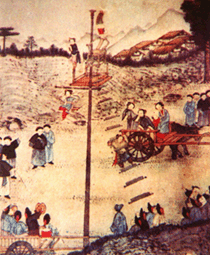Part four focuses on circus performances and stunts performed on drum carts. Great skill and daring is quite obviously required to perform handstands and spinning meteor-like bulbs on the backs of galloping horses or on moving drum carts. Numerous ancient items, including hand tricks, handstands, tightrope walking, horsemanship, and pole climbing on moving carts, are still performed in modern China.
 Characteristics of Chinese Acrobatics
Characteristics of Chinese Acrobatics
 Chinese acrobatics ranks among the best in the world thanks to its long history, rich repertory, and distinctive artistic characteristics. The artistic characteristics can be summarized as follows:
Chinese acrobatics ranks among the best in the world thanks to its long history, rich repertory, and distinctive artistic characteristics. The artistic characteristics can be summarized as follows:
First, Chinese acrobatics has long stressed the basic training of the waist and legs, and has attached great importance to the skill of standing on the head and hands as evidenced by many Han Dynasty brick paintings, murals, and pottery figurines that feature headstands, handstands, and somersaults. Performers of traditional magic were required to have good acrobatic skills. Otherwise, the fact that they were usually clad in a loose gown concealing scores of objects weighing as much as 100 pounds would have prevented them from doing somersaults while producing objects like bowls filled with water or blazing metal bowls.
Second, Chinese acrobatics is characterized by feats of strength and daring performed cleverly, precisely, and accurately, and the ability of retaining balance in motion. The ability of Chinese acrobats to perform rope-dancing stunts on a stack of benches placed on a plank and building pyramids on a free-standing ladder shows their superb skills at stabilizing themselves and retaining their balance in motion --- skills that require years of hard training and skills that reflect human's spirit of braving hardships and danger.
Third, the traditional form of conjuring known as "ancient splendor," which flourished during the Han and Tang (618-907) dynasties, seems to create something from nothing. The difference between Western magic and traditional Chinese magic is that the former conjurers stress stage sets, lighting, and sound effects, while their Chinese counterparts, whther than emphasizing stage design, use only limited props and instead hide most of objects needed beneath their loose gowns. Therefore, high-level skill and physical strength is needed for the Chinese conjurers to handle the hidden objects.
They are able to produce a wide range of objects from their loose gowns, including enough dishes for an 18-course dinner, as well as live fish and birds. In addition, they can even conjure a blazingbronzefire pan from their gowns immediately after one somersault and a large glass container filled with water and fish after the next. The art of conjuring is an expression of human's wisdom and reflects the desire to create material and spiritual wealth, as well as aspirations for a happy life.
